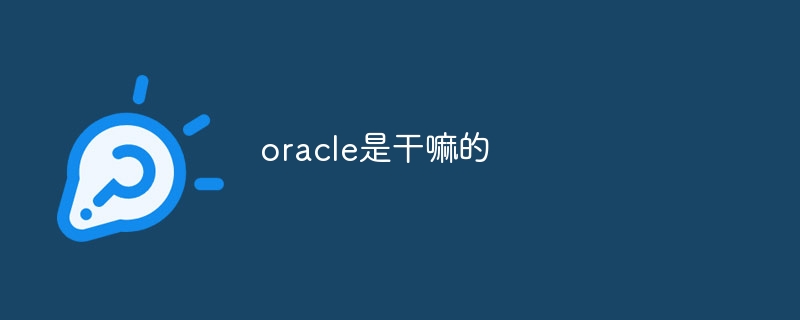
Course Introduction:The key points of WebLogic update and upgrade under CentOS system are explained in detail. Perform WebLogic updates or upgrade operations on CentOS system. Be sure to pay attention to the following key things to ensure the smooth upgrade process and the system runs stably: System compatibility verification: Before upgrading, please carefully verify whether the target WebLogic version is compatible with your CentOS system version. For example, the CentOS7.9 system needs to match the corresponding WebLogic installation package. Dependency checking: Make sure that all WebLogic dependencies (including Java runtime environment, necessary library files, etc.) are correctly installed and version compatible. Configuration file adjustment: During the upgrade process, WebLogic
2025-04-14 comment 0 757

Course Introduction:Configuring WebLogic database connection on a CentOS system requires the following steps: JDK installation and environment configuration: Make sure that the server has installed a JDK that is compatible with the WebLogic version (for example, WebLogic14.1.1 usually requires JDK8). Correctly set JAVA_HOME, CLASSPATH and PATH environment variables. WebLogic installation and decompression: Download the WebLogic installation package for CentOS system from the official Oracle website and unzip it to the specified directory. WebLogic user and directory creation: Create a dedicated WebLogic user account and set a security password
2025-04-14 comment 0 741

Course Introduction:To adjust the WebLogic log level in CentOS system, you need to modify the logging.xml configuration file of WebLogic. The specific steps are as follows: locate the logging.xml file: the logging.xml file is usually located in the wlserver/server/lib folder under the WebLogic installation directory. Edit logging.xml file: Use a text editor (such as vi or nano) to open the logging.xml file. You can set the storage path and file name of the WebLogic server log file by modifying the tag. Tags are used to configure the console log output level. Sample configuration snippet
2025-04-14 comment 0 1157

Course Introduction:Detailed explanation of WebLogic high availability scheme under the CentOS platform This article will introduce several common methods to achieve WebLogic high availability on CentOS systems, including using Keepalived and Nginx to build dual-machine hot standby, using DRBD to achieve data redundancy, and deploying WebLogic clusters. Which option you choose depends on your specific needs and environment. 1. Dual-machine high-availability solution based on Keepalived and Nginx This solution realizes the drift of virtual IP through Keepalived and load balancing is combined with Nginx. Environment preparation: Plan the main and backup servers and assign an unused IP address to the virtual IP. Installation and configuration:
2025-04-14 comment 0 554

Course Introduction:Oracle is the world's largest database management system (DBMS) software company. Its main products include the following functions: relational database management system (Oracle database) development tools (Oracle APEX, Oracle Visual Builder) middleware (Oracle WebLogic Server, Oracle SOA Suite) cloud service (Oracle Cloud Infrastructure) analysis and business intelligence (Oracle Analytics Cloud, Oracle Essbase) blockchain (Oracle Blockchain Pla
2025-04-11 comment 0 482

Course Elementary 13770
Course Introduction:Scala Tutorial Scala is a multi-paradigm programming language, designed to integrate various features of object-oriented programming and functional programming.

Course Elementary 82280
Course Introduction:"CSS Online Manual" is the official CSS online reference manual. This CSS online development manual contains various CSS properties, definitions, usage methods, example operations, etc. It is an indispensable online query manual for WEB programming learners and developers! CSS: Cascading Style Sheets (English full name: Cascading Style Sheets) is an application used to express HTML (Standard Universal Markup Language).

Course Elementary 13144
Course Introduction:SVG is a markup language for vector graphics in HTML5. It maintains powerful drawing capabilities and at the same time has a very high-end interface to operate graphics by directly operating Dom nodes. This "SVG Tutorial" is intended to allow students to master the SVG language and some of its corresponding APIs, combined with the knowledge of 2D drawing, so that students can render and control complex graphics on the page.

Course Elementary 24589
Course Introduction:In the "AngularJS Chinese Reference Manual", AngularJS extends HTML with new attributes and expressions. AngularJS can build a single page application (SPAs: Single Page Applications). AngularJS is very easy to learn.

Course Elementary 27446
Course Introduction:Go is a new language, a concurrent, garbage-collected, fast-compiled language. It can compile a large Go program in a few seconds on a single computer. Go provides a model for software construction that makes dependency analysis easier and avoids most C-style include files and library headers. Go is a statically typed language, and its type system has no hierarchy. Therefore users do not need to spend time defining relationships between types, which feels more lightweight than typical object-oriented languages. Go is a completely garbage-collected language and provides basic support for concurrent execution and communication. By its design, Go is intended to provide a method for constructing system software on multi-core machines.
linux - scheduled task every minute cannot be executed
2017-06-05 11:11:41 0 3 964
nginx - Questions about WeChat payment on WeChat official account:
2017-05-16 17:07:33 0 1 899
Laravel Modal does not return data
2024-03-29 10:31:31 0 1 591
Can I use the automatic generation module of thinkphp5 in Windows 7 system? How to configure and use
2017-10-10 17:04:14 0 2 1389